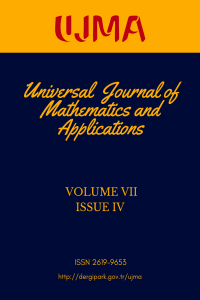Öz
The process of creating univalent harmonic mappings which are not analytic is not simple or straightforward. One efficient method for constructing desired univalent harmonic maps is by taking the linear combination of two suitable harmonic maps. In this study, we take into account two harmonic, univalent, and convex in the horizontal direction mappings, which are horizontal shears of $\Psi_{m}(z)=\frac{1}{2i\sin \gamma_{m}}\log \left( \frac{ 1+ze^{i\gamma_{m}}}{%
1+ze^{-^{i\gamma_{m}}}}\right),$ and have dilatations $\omega _{1}(z)=z,$
$\omega _{2}(z)=\frac{z+b}{1+bz},$ $b\in (-1,1).$ We obtain sufficient conditions for the linear combination of these two harmonic mappings to be univalent and convex in the
horizontal direction. In addition, we provide an example to illustrate the
result graphically with the help of Maple.
Anahtar Kelimeler
Convex in one direction Harmonic Linear combination Univalent
Kaynakça
- [1] H. Lewy, On the non-vanishing of the Jacobian in certain one-to-one mappings, Bull. Amer. Math. Soc., 42 (1936), 689-692.
- [2] J. Clunie, T. Sheil-Small, Harmonic univalent functions, Ann. Acad. Sci. Fenn. Math., 9 (1984), 3-25.
- [3] P. Duren, Harmonic Mapping In The Plane, Cambridge University Press, Cambridge, 2004.
- [4] S. Çakmak, E. Yaşar, S. Yalçın, Convolutions of harmonic mappings convex in the horizontal direction, J. Funct. Spaces, 2021 (2021), Article ID 2949573, 9 pages, doi:10.1155/2021/2949573.
- [5] M. Dorff, J. Rolf, (Eds.), Anamorphosis, Mapping Problems, and Harmonic Univalent Functions, in Explorations in Complex Analysis, Math. Assoc. of America, Inc., Washington DC, 2012.
- [6] B. Long, M. Dorff, Linear combinations of a class of harmonic univalent mappings, Filomat, 32(9) (2018), 3111-3121.
- [7] R. Kumar, S. Gupta, S. Singh, Linear combinations of univalent harmonic mappings convex in the direction of the imaginary axis, Bull. Malays. Math. Sci. Soc., 39(2) (2016), 751-763.
- [8] Z. G. Wang, Z. H. Liu, Y. C. Li, On the linear combinations of harmonic univalent mappings, J. Math. Anal. Appl., 400(2) (2013), 452-459.
- [9] M. Demirçay, Linear combinations of harmonic univalent functions, Master’s Thesis, Bursa Uludag University, 2023.
- [10] M. Demirçay, E. Yaşar, Linear Combinations of Harmonic Univalent Mappings Convex In The Horizontal Direction, 1st International Conference on Engineering and Applied Natural Sciences, Konya, T¨urkiye, (2022), 1595.
- [11] Q. I. Rahman, G. Schmeisser, Analytic Theory Of Polynomials, London Mathematical Society Monographs New Series, Vol. 26, Oxford University Press, Oxford, 2002.
- [12] A. Aleman, A. Constantin, Harmonic maps and ideal fluid flows, Arch. Ration. Mech. Anal., 204 (2012), 479–513.
Öz
The process of creating univalent harmonic mappings which are not analytic is not simple or straightforward. One efficient method for constructing desired univalent harmonic maps is by taking the linear combination of two suitable harmonic maps. In this study, we take into account two harmonic, univalent, and convex in the horizontal direction mappings, which are horizontal shears of $\Psi_{m}(z)=\frac{1}{2i\sin \gamma_{m}}\log \left( \frac{ 1+ze^{i\gamma_{m}}}{%
1+ze^{-^{i\gamma_{m}}}}\right),$ and have dilatations $\omega _{1}(z)=z,$
$\omega _{2}(z)=\frac{z+b}{1+bz},$ $b\in (-1,1).$ We obtain sufficient conditions for the linear combination of these two harmonic mappings to be univalent and convex in the
horizontal direction. In addition, we provide an example to illustrate the
result graphically with the help of Maple.
Anahtar Kelimeler
Convex in one direction Harmonic Linear combination Univalent
Kaynakça
- [1] H. Lewy, On the non-vanishing of the Jacobian in certain one-to-one mappings, Bull. Amer. Math. Soc., 42 (1936), 689-692.
- [2] J. Clunie, T. Sheil-Small, Harmonic univalent functions, Ann. Acad. Sci. Fenn. Math., 9 (1984), 3-25.
- [3] P. Duren, Harmonic Mapping In The Plane, Cambridge University Press, Cambridge, 2004.
- [4] S. Çakmak, E. Yaşar, S. Yalçın, Convolutions of harmonic mappings convex in the horizontal direction, J. Funct. Spaces, 2021 (2021), Article ID 2949573, 9 pages, doi:10.1155/2021/2949573.
- [5] M. Dorff, J. Rolf, (Eds.), Anamorphosis, Mapping Problems, and Harmonic Univalent Functions, in Explorations in Complex Analysis, Math. Assoc. of America, Inc., Washington DC, 2012.
- [6] B. Long, M. Dorff, Linear combinations of a class of harmonic univalent mappings, Filomat, 32(9) (2018), 3111-3121.
- [7] R. Kumar, S. Gupta, S. Singh, Linear combinations of univalent harmonic mappings convex in the direction of the imaginary axis, Bull. Malays. Math. Sci. Soc., 39(2) (2016), 751-763.
- [8] Z. G. Wang, Z. H. Liu, Y. C. Li, On the linear combinations of harmonic univalent mappings, J. Math. Anal. Appl., 400(2) (2013), 452-459.
- [9] M. Demirçay, Linear combinations of harmonic univalent functions, Master’s Thesis, Bursa Uludag University, 2023.
- [10] M. Demirçay, E. Yaşar, Linear Combinations of Harmonic Univalent Mappings Convex In The Horizontal Direction, 1st International Conference on Engineering and Applied Natural Sciences, Konya, T¨urkiye, (2022), 1595.
- [11] Q. I. Rahman, G. Schmeisser, Analytic Theory Of Polynomials, London Mathematical Society Monographs New Series, Vol. 26, Oxford University Press, Oxford, 2002.
- [12] A. Aleman, A. Constantin, Harmonic maps and ideal fluid flows, Arch. Ration. Mech. Anal., 204 (2012), 479–513.
Ayrıntılar
| Birincil Dil | İngilizce |
|---|---|
| Konular | Temel Matematik (Diğer) |
| Bölüm | Makaleler |
| Yazarlar | |
| Erken Görünüm Tarihi | 28 Ekim 2024 |
| Yayımlanma Tarihi | 9 Aralık 2024 |
| Gönderilme Tarihi | 7 Nisan 2024 |
| Kabul Tarihi | 13 Ekim 2024 |
| Yayımlandığı Sayı | Yıl 2024 Cilt: 7 Sayı: 4 |
Kaynak Göster
Universal Journal of Mathematics and Applications
 The published articles in UJMA are licensed under a Creative Commons Attribution-NonCommercial 4.0 International License.
The published articles in UJMA are licensed under a Creative Commons Attribution-NonCommercial 4.0 International License.


